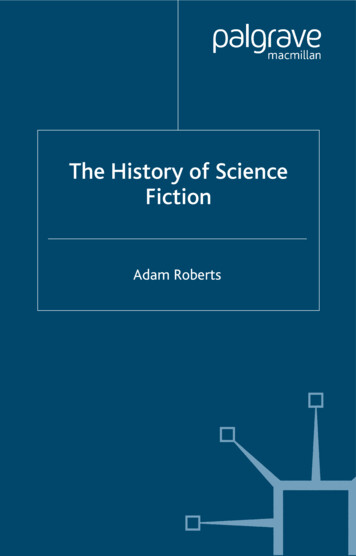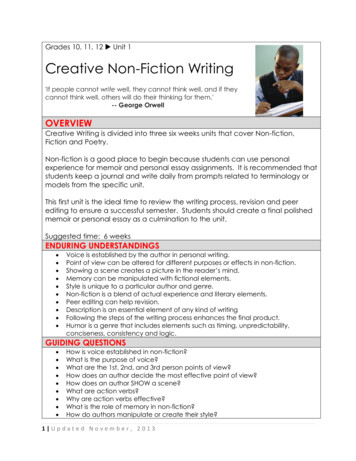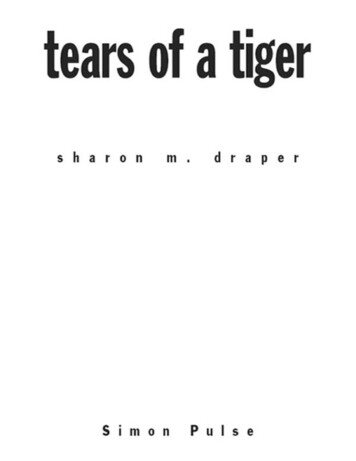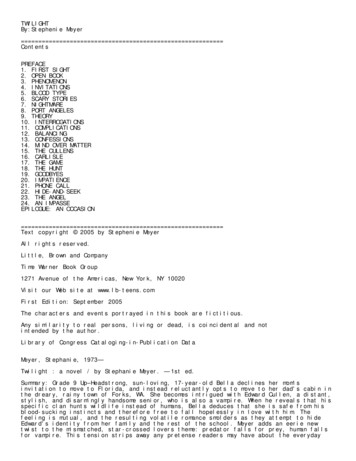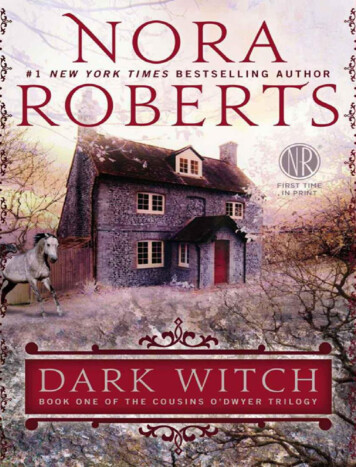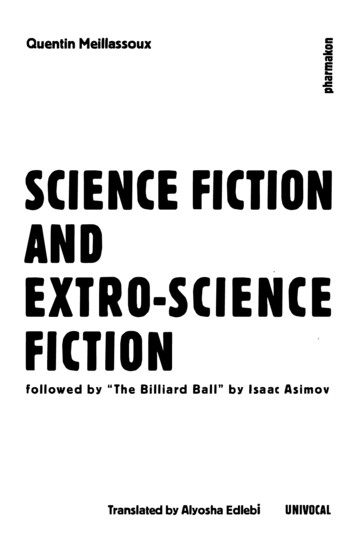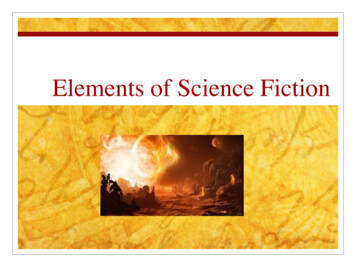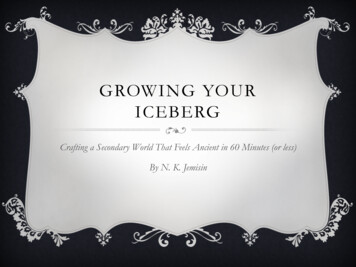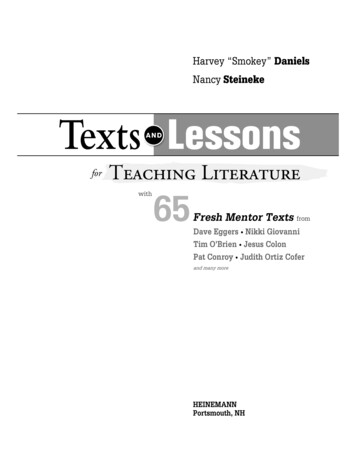
Transcription
TL Fiction Chapter FM Layout 1 2/6/13 11:56 AM Page i
TL Fiction Chapter FM Layout 1 2/6/13 11:56 AM Page iiHeinemann361 Hanover StreetPortsmouth, NH 03801–3912www.heinemann.comOffices and agents throughout the world 2013 by Harvey Daniels and Nancy SteinekeAll rights reserved. No part of this book may be reproduced in any form or by anyelectronic or mechanical means, including information storage and retrieval systems,without permission in writing from the publisher, except by a reviewer, who may quotebrief passages in a review, with the exception of reproducible pages, which areidentified by the Texts and Lessons for Teaching Literature credit line and may bephotocopied for classroom use only.“Dedicated to Teachers” is a trademark of Greenwood Publishing Group, Inc.The authors and publisher wish to thank those who have generously given permissionto reprint borrowed material:Choices Made by Jim O’Loughlin. Copyright 2009 by Jim O’Loughlin. Reprinted bypermission of the Author.“Tuning” from The Winter Room by Gary Paulsen. Copyright 1989 by Gary Paulsen.Published by Scholastic. Reprinted by permission of Flannery Literary Agency.continues on page viiLibrary of Congress Cataloging-in-Publication DataDaniels, Harvey.Texts and lessons for teaching literature : with 65 fresh mentor texts from DaveEggers, Nikki Giovanni, Pat Conroy, Jesus Colon, Tim O’Brien, Judith Ortiz Cofer, andmany more / Harvey “Smokey” Daniels and Nancy Steineke.pages cm.Includes bibliographical references.ISBN-13: 978-0-325-04435-4ISBN-10: 0-325-04435-X1. Literature—Study and teaching (Middle school). 2. Literature—Study andteaching (Secondary). 3. Content area reading. I. Steineke, Nancy, author.II. Title.LB1575.D36 20132012046368807.12—dc23Editor: Tobey AntaoProduction management: Sarah WeaverProduction coordination: Patty AdamsCover and interior design: Lisa Anne FowlerTypesetter: Gina Poirier DesignManufacturing: Steve BernierPrinted in the United States of America on acid-free paper17 16 15 14 13 ML 1 2 3 4 5
TL Fiction Chapter FM Layout 1 2/6/13 11:56 AM Page iiiCONTENTSCHAPTER1WelcomeCHAPTER2How to Use This BookCHAPTER3Sharing Literature Aloud3.11Pair Share61818“Choices Made” by Jim O’Loughlin3.2Teacher Read-Aloud2122“Tuning,” Preface from The Winter Room by Gary Paulsen3.3One-Minute Write26“The Limited” by Sherman Alexie3.43.5Teacher Think-Aloud29“Untitled” by Dan Argent32Partner Think-Aloud2833“There’s No Place Like It” by Dean Christianson“Death in the Afternoon” by Priscilla MintlingCHAPTER4Smart-Reader Strategies4.1Text Annotation35363737“Afterthoughts” by Sara Holbrook41“The Boy They Didn’t Take Pictures Of” by Dave Eggers4.2Connections and Disconnections“Ambush” by Roger Woodward4.3Drawing Text DetailsInferring Meaning50Tweet the Text515456Assorted Six-Word Memoirs4.64346Reading with Questions in Mind“Noel” by Roger Plemmons4.54247“Ascent” by Michael Salinger4.4255759“The Sweet Perfume of Good-Bye” by M. E. Kerr62ContentsIII
TL Fiction Chapter FM Layout 1 2/6/13 11:56 AM Page ivCHAPTER5Lively Discussions5.165Written Conversation66“Rose” by John Biguenet5.271Thirty-Second Look73Mining Village by Stevan Dohanos5.3Follow-Up Questions7677“Deportation at Breakfast” by Larry Fondation5.45.5Save the Last Word for Me83“Stingray” by Michael Salinger86Literature Circles8189“The Chimpanzees of Wyoming” by Don ZancanellaCHAPTER6Closer n Schlemieleon” by Patric S. Tray6.2Setting the Scene107108Wanderer in the Storm by Carl Julius von Leypold6.3Two-Column NotesPoint-of-View Note Taking“Accident” by Dave Eggers6.5Seeing a Character116117120121Untitled by James Henry Moser6.6111112“Forwarding Order Expired” by John M. Daniel6.4Metaphorically Speaking“Fight #3” by Helen Phillips124126129“How the Water Feels to the Fishes” by Dave Eggers6.7Rereading Prose131“The Father” by Raymond Carver6.8Rereading Poetry7Up and Thinking141Find an Expert1417.1“The Horror” by Dave Eggers7.2Text on Text140148149“I Am From” by Lorian Dahkai7.3Frozen Scenes153“This Is How I Remember It”by Betsy Kemper (mature) 157IVContents136137“Ducks” by Michael SalingerCHAPTER94152130
TL Fiction Chapter FM Layout 1 2/6/13 11:56 AM Page v7.4The Human Continuum158“Little Things Are Big” by Jesus Colon7.5Character Interview Cards161163“The Container” by Deb Olan UnferthCHAPTER8Literary Arguments8.1Take a Position169169“We? #5” by Helen Phillips8.2Finish the Story167172173TM“Little Brother ” by Bruce Holland Rogers8.3Arguing Both Sides180“The Wallet” by Andrew McCuaigCHAPTER9177185Coping with Complex and Classic Texts9.1Literary Networking187“The Storyteller” by Saki9.2Characters Texting187192196“Persephone and Demeter” by Thomas Bulfinch9.3Opening Up a Poem203“The Listeners” by Walter de la Mare9.4Stop, Think, and React206207“The Cask of Amontillado” by Edgar Allan Poe9.5199Reading with Expression211217“Witches’ Chant” from Macbeth by William ShakespeareCHAPTER1 0 Text Set Lessons1Memory220223224“Kennedy in the Barrio” by Judith Ortiz Cofer226Excerpt from the Warren Commission Report (1964)227Announcement of President Kennedy’s Deathby Walter Cronkite (available online)2Citizenship229“Canvassing for the School Levy” by Sara Holbrook3Life Stories231232“Nikki-Rosa” by Nikki Giovanni235“Nikki Giovanni Biography” from Wikipedia236“Giovanni Timeline” by Nikki Giovanni (available online)ContentsV
TL Fiction Chapter FM Layout 1 2/6/13 11:56 AM Page vi4Mothers and Daughters237“Persephone and Demeter”by Thomas Bulfinch199 (Lesson 9.2)“Mother #1” by Helen Phillips241“Mother Disapproved of Him” (mature)by Rita Mae Brown 2425Narcissism244Narcissus by Caravaggio (available online)“Narcissus and Echo” (adapation) by Ovid“Narcissism” from Wikipedia248“The Stag and His Reflection” by Aesop6Labels246249250“Labels” by Sara Holbrook252“Sitting Bull Returns” at the Drive-Inby Willard Midgette 253“Sure You Can Ask Me a Personal Question”by Diane Burns 254“On Making Him a Good Man by Calling Hima Good Man” by Dave Eggers 256“Speech at the U.S. Capitol” by Mandeep Chahal7Abuse257260“Dozens of Roses: A Story for Voices”by Virginia Euwer Wolff 263“The Wallet” by Andrew McCuaig185 (Lesson 8.3)“My Father” (mature) by Pat Conroy8Soldiers and Heroes265267“Broadcaster Refuses to Label DeadSoldiers ‘Heroes’” by Lee Terrell 271The Advance Guard, or The Military Sacrifice(The Ambush) by Frederic Remington 272“Three Soldiers” by Bruce Holland Rogers“The News from Iraq” by Sara Holbrook“Heroes” by Tim O’BrienCHAPTER279How the Lessons Correlatewith the Common Core StandardsWorks CitedContents2771 2 Extending the Texts and LessonsAppendixVI2741 1 Keeping Kids at the Centerof Whole-Class NovelsCHAPTER273302300294
TL Fiction Chapter FM Layout 1 2/6/13 11:56 AM Page viiCredits continued from page ii:“The Limited” from War Dances, copyright 2009 bySherman Alexie. Used by permission of Grove/Atlantic,Inc., and Nancy Stauffer Associates.“Untitled” by Dan Argent from New Scientist Magazine,August 2009. Copyright 2009 Reed BusinessInformation–UK. All rights reserved. Distributedby Tribune Media Services.“There’s No Place Like It” by Dean Christianson, “Death inthe Afternoon” by Priscilla Mintling, and “ChameleonSchlemieleon” by Patric Tray from World’s Shortest Stories,edited by Steve Moss. Copyright Jan. 1, 1998. Reprinted bypermission of Running Press Book Publishers, a member ofthe Perseus Books Group via Copyright Clearance Center.“Accident,” “The Boy They Didn’t Take Pictures Of,” “Howthe Water Feels to the Fishes,” “The Horror,” and “OnMaking Him a Good Man by Calling Him a Good Man”from How the Water Feels to the Fishes: 145 Stories in aSmall Box by Dave Eggers. Copyright 2007 by DaveEggers. Published by McSweeney’s, San Francisco.Reprinted by permission of the Author.Poems: “Afterthoughts,” “Canvassing for the School Levy,”“Labels,” and “The News from Iraq” by Sara Holbrook.Reprinted by permission of the Author.Poems: “Ducks,” “Ascent,” and “Stingray” by MichaelSalinger. Reprinted by permission of the Author.“Chimpanzees of Wyoming” from Western Electric by DonZancanella. Copyright 1996 by Don Zancanella. Published by University of Iowa Press. Reprinted by permission of the Publisher.“Forwarding Order Expired” by John M. Daniel. Reprintedby permission of the Author.“Fight #3,” “We? #5,” and “Mother #1” from And Yet TheyWere Happy by Helen Phillips. Leapfrog Press, Leaplit,2011. Reprinted by permission of the Publisher.“The Father” from Will You Be Quiet, Please? by RaymondCarver. Copyright 1992 by Raymond Carver. Reprintedby permission of International Creative Management, Inc.“This Is How I Remember It” by Elizabeth Kemper French.Reprinted by permission of the Author.“Little Things Are Big” by Jesus Colon from Choosing toParticipate. Copyright 2009 by Facing History andOurselves National Foundation. Reprinted by permissionof International Publishers Company, Inc., New York, andFacing History and Ourselves National Foundation.“The Container” from Minor Robberies: 145 Stories in aSmall Box by Deb Olin Unferth. Copyright 2007 by DebOlin Unferth. Published by McSweeney’s, San Francisco.Reprinted by permission of the Author.“Noel” by Michael Plemmons. Copyright 1985 byMichael Plemmons. First appeared in the North AmericanReview. Reprinted by permission of the Author.“Little Brother ” by Bruce Holland Rogers as appearedin Strange Horizons. www.strangehorizons.com,October 2000. Reprinted by permission of the Author.www.shortshortshort.com.“The Sweet Perfume of Good-bye” by M. E. Kerr fromVisions: Nineteen Short Stories by Outstanding Writers forYoung Adults, edited by Donald R. Gallo. Copyright 1987 by Bantam Doubleday Dell. Reprinted by permissionof the Author.“Three Soldiers” by Bruce Holland Rogers as appeared inFlash Fiction Forward: 80 Very Short Stories, edited byJames Thomas and Robert Shapard. Copyright 2006 byW. W. Norton. Reprinted by permission of the Author.www.shortshortshort.com.“Rose” from The Torturer’s Apprentice by John Biguenet.Copyright 2000 by John Biguenet. Reprinted by permission of HarperCollins Publishers.“The Wallet” by Andrew McCuaig. Originally appeared inBeloit Fiction Journal (2001), Vol. 17, p. 130. Reprinted bypermission of the Author.“Deportation at Breakfast” by Larry Fondation as appearedin Flash Fiction: 72 Very Short Stories, edited by JamesThomas, Denise Thomas, and Tom Hazuka. Copyright 1992 by W. W. Norton. Reprinted by permission of the Author.“Kennedy in the Barrio” by Judith Ortiz Cofer is reprintedwith permission from the publisher of “Year of Our Revolution” by Tomas Rivera ( 1998 Arte Público Press—University of Houston).VII
TL Fiction Chapter FM Layout 1 2/6/13 11:56 AM Page viiiCredits, continuedPHOTO CREDITS“Nikki-Rosa” from Black Feeling, Black Talk, Black Judgement by Nikki Giovanni. Copyright 1972 by Nikki Giovanni. Reprinted by permission of the Author.Frederic Remington (1861–1909), American, The AdvanceGuard, or The Military Sacrifice (The Ambush), 1890. Oilon canvas, 87.3 123.1 cm (34 ⅜ 48 ½ in.). George F.Harding Collection, 1982.802, The Art Institute of Chicago.“Mother Disapproved of Him” by Rita Mae Brown from3 Minutes or Less: Life Lessons from America’s GreatestWriters. Copyright 2000 by PEN/Faulkner Foundation.Reprinted by permission of Bloomsbury Publishing Plc.“Sure, You Can Ask Me a Personal Question” by DianeBurns from Aloud! Voices from the Nuyorican Poets Café.Copyright 1994 by Michael Algarin and Bob Holman.Published by Henry Holt and Company, LLC. Reprintedby permission of the Copyright Holder.“Dozens of Roses: A Story for Voices” by Virginia EuwerWolff. Copyright 1997 by Virginia Euwer Wolff. Firstappeared in From One Experience to Another publishedby Tom Doherty Associates. Reprinted by permission ofCurtis Brown, Ltd.“My Father,” copyright 2000 by Pat Conroy. Originallyappeared in 3 Minutes or Less: Life Lessons from America’sGreatest Writers, edited by PEN/Faulkner Foundation.Reprinted by permission of Marly Rusoff Literary Agencyfor the Author.“Heroes” by Tim O’Brien from 3 Minutes or Less: Life Lessons from America’s Greatest Writers. Copyright 2000 byPEN/Faulkner Foundation. Reprinted by permission ofBloomsbury Publishing Plc.VIIIJulius von Leypold (1806–1874), Wanderer in the Storm.Germany, 1835. Oil on canvas, 16 ¾ 22 ¼ in. (42.5 56.5cm). Catharine Lorillard Wolfe Collection, Wolfe Fund,2008 (2008.7). The Metropolitan Museum of Art, NewYork, NY, USA.Willard Midgette (1937–1978), “Sitting Bull Returns” at theDrive-In, 1976. Oil on canvas, 108 ¼ 134 ⅛ in. Gift ofDonald B. Anderson. Smithsonian American Art Museum,Washington, DC, USA.Stevan Dohanos (1907–1994), Mining Village (Study formural, Huntington, West Virginia, forestry service building), 1937. Tempera on fiberboard. Sheet: 15 ⅞ 17 in.(40.3 43.2 cm); Image: 12 ⅜ 14 in. (31.3 35.7 cm).Transfer from the General Services Administration(1974.28.308). Smithsonian American Art Museum, Washington, DC, USA.James Henry Moser (1854–1913), Untitled (Two ChildrenPlaying Checkers), n.d. Pastel on paper, frame: 21 17 in.(53.3 43.2 cm). Bequest of Carolyn A. Clampitt in memory of the J. Wesley Clampitt, Jr. Family (2010.10). Smithsonian American Art Museum, Washington, DC, USA.
TL Fiction Chapter1-3 Layout 1 2/6/13 12:00 PM Page 1CHAPTER1WELCOMEGREETINGS, COLLEAGUES. We are Smokey Daniels and Nancy Steineke, joining you again with a new resource that we hope you’ll find useful.Over the past several years, we have worked with students and teachers intwenty-two states, conducting reading workshops and giving demonstrationlessons in middle and high school classrooms. Nancy’s day job is at Victor J.Andrew High School in suburban Chicago, where she has taught language arts(and once upon a time, home economics, but that’s another story) for thirtyfive years. Since Smokey no longer has a classroom of his own, he now logs frequent-flier miles as a cross-country guest teacher, including stints at schools inChicago, Appalachia, Arkansas, New York, Texas, New Mexico, Wisconsin, andHawaii (someone has to do it), along with writing books and leading workshops.In 2011 we published Texts and Lessons for Content-Area Reading, whichincluded collaborative comprehension lessons and kid-friendly nonfiction articles from a crazy array of sources (Rolling Stone, the Discovery Channel, the NewYork Times, etc). Since that book came out, English language arts teachers havebeen requesting a companion volume that uses literature instead of informationaltext to teach deep comprehension and collaborative discussion. They wanted abook that’s just for us ELA folks, not those greedy history and science teachersserved by the previous book. Our first love is literature, too. Who are we to refuse?So here’s the product of our two-year search for the best, freshest, andmost engaging short literature for young people—and a collection of new, stepby-step lessons that guide kids into, through, and beyond these texts. As withthe nonfiction edition, these lessons use engaging short selections to teachclose reading and deep comprehension through collaborative conversationand lively debate. And every lesson in the book is correlated with the CommonCore Anchor Standards for Reading—as well as many standards for Speakingand Listening, Language, and Writing.Meeting and Exceeding the Common CoreState StandardsThe experiences provided by our upcoming thirty-seven lessons closely parallelthe readings and tasks recommended by the Common Core State Standards(CCSS) as well as the performances required in tests from the Partnership forAssessment of Readiness for College and Careers (PARCC) and Smarter BalancedAssessment Consortium (SBAC). The main difference is that our lessons put student curiosity and engagement first. The experiences are highly active and student centered, unlike so many of the CCSS prep materials being developedaround the country.CHAPTER 1 / Welcome1
TL Fiction Chapter1-3 Layout 1 2/6/13 12:00 PM Page 2In recent years, the Common Core Standards have had a dramatic and sometimes unsettling impact on schools and teachers. We have plenty to say about thechallenges of the Core, but luckily for you, we are not going to do it here. Thisbook is about addressing the standards, not critiquing them. Smokey and our colleagues Steve Zemelman and Arthur Hyde recently released the fourth edition ofBest Practice: Bringing Standards to Life in America’s Classrooms (Heinemann2012). That book offers an extended and balanced treatment of the CCSS—andthe many other standards documents and research studies that, together, provide a full vision of what excellent teaching and learning look like today.For now, we’ll just show how this resource can help you engage your kidsand meet the CCSS for the English Language Arts, and in particular the ReadingStandards for Literature 6–12. To begin with, here are the anchors:College and Career Readiness Anchor Standards for ReadingKEY IDEAS AND DETAILS1. Read closely to determine what the text says explicitly and to makelogical inferences from it; cite specific textual evidence when writing or speaking to support conclusions drawn from the text.2. Determine central ideas or themes of a text and analyze theirdevelopment; summarize the key supporting details and ideas.3. Analyze how and why individuals, events, and ideas develop andinteract over the course of a text.CRAFT AND STRUCTURE4. Interpret words and phrases as they are used in a text, includingdetermining technical, connotative, and figurative meanings, andanalyze how specific word choices shape meaning or tone.5. Analyze the structure of texts, including how specific sentences,paragraphs, and larger portions of the text (e.g., a section, chapter,scene, or stanza) relate to each other and the whole.6. Assess how point of view or purpose shapes the content and styleof a text.INTEGRATION OF KNOWLEDGE AND IDEAS7. Integrate and evaluate content presented in diverse formats andmedia, including visually and quantitatively as well as in words.8. Delineate and evaluate the argument and specific claims in a text,including the validity of the reasoning as well as the relevance andsufficiency of the evidence.9. Analyze how two or more texts address similar themes or topicsin order to build knowledge or to compare the approaches theauthors take.2CHAPTER 1 / Welcome
TL Fiction Chapter1-3 Layout 1 2/6/13 12:00 PM Page 3RANGE OF READING AND LEVEL OF TEXT COMPLEXITY10. Read and comprehend complex literary and informational textsindependently and proficiently.(www.corestandards.org/assets/CCSSI ELA%20Standards.pdf)When you think about this list, you realize that any good reading lessonshould incorporate all of these goals. Why would we ever design a lesson inwhich kids didn’t take all text details into account, pay attention to the author’scraft, build knowledge, and gain proficiency with challenging materials? Students deserve it all. So every lesson in this book helps students gain practicewith most or all of the reading anchor standards.While our main aim in this book is to enhance the reading of literature, wealso address other Common Core Standards in Speaking and Listening, Language, and Writing, and these correlations are prominently noted. For example,every lesson includes both small-group and whole-class discussion, as explicitlycalled for in the Speaking and Listening Standards. And, since all sixty-five ofthe reading selections reproduced here model excellence in language use, thelessons also help students meet key Language Standards. And finally, most lessons require some kind of student writing or note taking. While the writtenassignments are mostly brief and informal, each one helps to build the fluency,skills, and process knowledge students need to meet the Writing Standards.Prominent sidebars will help you see which Common Core Standards andskills are receiving special focus and attention all the way through the book.Then, in the appendix, we offer a chart that helps you correlate the lessons withall relevant standards.About the Readings: What’s Fresh in the Market?Sometimes it seems as though the same fifty short stories and the same fifteenpoems are anthologized over and over. Partly, that’s because the major textbookcompanies want to offer students time-tested readings from celebrated authors.But there are plenty of other works of great literature out there, if you knowwhere to look for something fresh.So where do we look? Both of us are inveterate and passionate collectors ofshort-short fiction and short poems, in both their tree-based and digital forms.If you looked at our voluminous email correspondence, or eavesdropped on ourweekly Saturday morning phone calls, you’d mainly hear us trading and readingaloud great short pieces.We are also inveterate and passionate teachers of reading comprehension,thinking, and discussion strategies. That means we need a constant supply ofshort texts to use in quick, lively, in-class lessons. When we introduce our students to almost any literary idea or device, it’s only natural to pull out a short literature piece from our collections. We came to call these texts “one-pagewonders” (OPW in shorthand) because we shopped for kid-friendly readingselections that could be photocopied on one or two pages.CHAPTER 1 / Welcome3
TL Fiction Chapter1-3 Layout 1 2/6/13 12:00 PM Page 4The reading selections we’ve collected here cover the genres of short stories,poems, drama, and novels, with some essays and accompanying nonfictionpieces appearing in the text sets (see Chapter 10). When choosing OPWs, wefavor selections that: are engaging, complex, and mostly contemporary feature newer, up-and-coming writers (or, if written by famous authors,are not widely anthologized) are fresh to us teachers, too, so we can have the joy of discovery rightalong with our kids have sufficient sensory detail and rich language to conjure up vividimages of places and characters have enough depth and craft to reward second, closer readings address themes that can stimulate lively discussion and debateamong students are short enough to be read during class, so that a whole lesson canbe completed in one period or less allow photocopying, so kids can annotate their own copies help students practice key comprehension and thinking strategies can be extended into more days, or tied into broader literature unitsWe want to be especially clear about text complexity, a key focus of the Common Core Standards. A few of our chosen readings are intentionally easy to enter,enjoy, and talk about. And why not? As the standards say, “Students need opportunities to stretch their reading abilities but also to experience the satisfaction andpleasure of easy, fluent reading, both of which the Standards allow for” (2010, p. 39).But our main job, year in and year out, is to lead our students up a ladder ofchallenge, building their stamina and pushing them along to literature thatrequires more intentional thinking. But along that ladder, it’s also our duty toprovide just the right amount and type of support to keep kids progressing.Every class period is not a high-stakes test; it is one more step upwardtoward college and career readiness. So, even as we respect the CCSS focus oncomplex text, we also think carefully about what makes that text accessible toyoung readers along that upward path of their growth. Here are the considerations we keep in mind:FACTORS THAT MAKE COMPLEX TEXT MORE ACCESSIBLE The text is shorter rather than longer. The reader has chosen the text, versus it being assigned. The reader has relevant background knowledge. The topic has personal interest or importance. The text evokes curiosity, surprise, or puzzlement. The text has high coherence, meaning that it explains itself (e.g., “JohnLangdon, a farmer and signer of the Constitution . . .”).4CHAPTER 1 / Welcome
TL Fiction Chapter1-3 Layout 1 2/6/13 12:00 PM Page 5 The teacher evokes and builds the reader’s background knowledge. The teacher teaches specific strategies for monitoring comprehension,visualizing, inferring, connecting to background knowledge, questioning, determining importance, and synthesizing. Readers can mark, write, or draw on text as they read. Readers are encouraged to talk about the text during and after reading. Readers can hear text read aloud by the teacher, by a classmate, or in asmall group. Readers have experience writing in the same genre.Still, make no mistake about it: 90 percent of the pieces in this collectionare plenty complex. That’s because they are full-strength adult literature, whichwe think middle and high school students should be engaging with regularly.So we didn’t worry so much about Lexiles; instead, we picked selections thatgrown-up, lifelong readers have paid to read. Trust us, there are plenty of pieceshere that give us English majors a run for our interpretive money, but are stillintriguing enough to keep teen readers digging and thinking.Which brings us back to the question in our subhead, What’s fresh in themarket? You hear that expression a lot on those TV cooking shows when thecameras follow a Famous Chef through the farmer’s market, right? She is lookingfor the dewiest veggies, the most exotic meats, the strangest grains (freekeh, seriously? kamut berries, really?), the revelatory ethnic treats. Great cooks seek thelatest, the newest, the weirdest. They want challenge. They want to create a dishthey’ve never cooked before. They want to work on the edge, take some risks,and dazzle their diners.If we literature teachers are chefs too, then we really need some fresh produce. To begin with, you just get tired of teaching To Kill a Mockingbird for thetwenty-third time (unless you’re Nancy). More importantly, when we teach anovel or story to our students, they too often see us “read” texts we have readmany times before, thought about, talked about, maybe even written about. Weknow it cold from all our previous encounters.But this is not the same job we ask kids to do when they come in the classroom each day. We place unfamiliar text in front of them and ask them to read it“cold.” They almost never see us encountering unknown text, working to buildmeaning the first time through. Well, if reading unfamiliar text is the students’actual task, then we teachers better be demonstrating that job, early and often.That means we need new texts to refresh and challenge ourselves.Now, these sixty-five little jewels won’t be our favorite literary clips forever;we’re always finding and adding new ones to the repertoire—and you should,too. As you work with these pieces, you’ll start to internalize what makes a onepage wonder, and start collecting your own. Hope you get as geeky about finding them as we are.So, shall we move on to the nuts and bolts of the lessons?CHAPTER 1 / Welcome5
TL Fiction Chapter1-3 Layout 1 2/6/13 12:00 PM Page 6CHAPTER2HOW TO USE THIS BOOKComing right up, Chapters 3 through 9 present thirty-seven strategy lessons forimproving students’ literary comprehension and discussion, using very shorttexts. In Chapter 10, we offer eight text set lessons, thematically connectedassortments of pieces designed to be studied, compared, and debated together.Then, in Chapter 11, we bring forward three commonly taught whole-class novels and show how you can use selected lessons from this book to teach thoseworks—and countless others—in a highly interactive, engaging way. And finally,in Chapter 12, we explain how to grow your own inventory of special texts forteaching literary thinking. Here’s the rundown.Chapters 3–9: Strategy LessonsThe strategy lessons are each accompanied by at least one “one-page wonder”—an enticing poem, short-short story, essay, or image that engages students inclose reading, thinking, and discussion. We selected these pieces with literaryquality and student engagement foremost in our minds. They cover a widerange of genres and themes; only a few are abridged. The lessons accompanyingthese readings offer specific suggestions and language you can use to teachthem. They are written as generally as possible, so you can use (and reuse) thesteps and language with any compatible text you choose. And the strategy lessons are quick: they are designed to be completed within ten to fifty minutes.We have grouped the lessons into seven families based on their thinkingfocus as well as their standards connections.Sharing Literature AloudSmart-Reader StrategiesLively DiscussionsCloser ReadingsUp and ThinkingLiterary ArgumentsCoping with Complex and Classic TextsThe strategy lessons appear in what we’d call a “mild sequential order.” Forexample, kids can’t do arguing both sides unless they first know how to pairshare with a classmate. Very generally, the lessons become more complex andsocially demanding as they unfold. But, that being said, use them in whateverorder you like; so far, no fatalities have been reported due to reordering. Youcan also mix and match—any lesson with any reading selection, ours or yours.If a piece looks too easy or hard for your kids, don’t give up on the lesson—findan alternative text elsewhere in the book or in your own collection, and carry6CHAPTER 2 / How to Use This Book
TL Fiction Chapter1-3 Layout 1 2/6/13 12:00 PM Page 7on. And remember, always study any potential lesson text carefully to be sure itis appropriate for your students and the community where you would like tocontinue teaching.Chapter 10: Text Set LessonsThe text sets follow a similar lesson format, but each one offers multiple coordinated reading selections. Now students can range though two to five texts representing different genres and authors, each of them taking a different angle ona common topic or literary theme. This formula includes nonfiction selectionsand various media in the mix, much as PARCC and Smarter Balanced assessments do. Among our themes:MemoryCitizenshipLife Stories
CHAPTER 1 Welcome 1 CHAPTER 2 How to Use This Book 6 CHAPTER 3 Sharing Literature Aloud 18 3.1 Pair Share 18 “Choices Made” by Jim O’Loughlin 21 3.2 Teacher Read-Aloud 22 “Tuning,” Preface from The Winter Room by Gary Paulsen 25 3.3 One-Minute Write 26 “The Limited” by Sherman Alexie 28 3.4 Teacher


